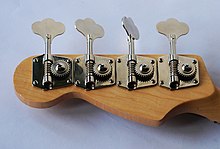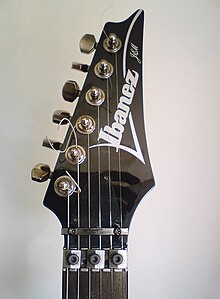Headstock

A headstock or peghead is part of a
Construction details

Two traditional layouts of guitar tuners are called "3+3" (3 top tuners and 3 bottom ones) and "6 in line" tuners, though many other combinations are known, especially for bass guitars and non-6-string guitars. When there are no machine heads (i.e. tuners are not needed or located in some other place, for example, on guitar body), the guitar headstock may be missing completely, as in

The headstock may be carved separately and glued to the neck using some sort of
- Straight headstocks form a single plane with a flat surface of the neck (and fingerboard). This makes the neck and headstock easier to manufacture; they can be constructed from a single piece of wood. Fender usually uses non-angled, straight headstocks. Because of the low angle of the string over the nut, string trees may be used to avoid the string coming out of the nut while playing.[1]
- Angled headstocks form some kind of acute anglewith a surface of the neck. The value of "magic angle" (called headstock pitch) that gives the best tone and stability is also very debatable, but it is usually in a range from 3° to 25°. For example, various manufacturers and particular guitar models use:
- Guitars
- 4°: Guild
- 11°: Martin[2]
- 12°: Bigsby,[3] Yamaha SGV[4]
- 13°: Peavey,[5] Warmoth[6][7]
- 14°: Gibson Firebird V[8] and VII,[9] Gibson X-plorer,[10] some vintage Gibson guitars,[11] Washburn,[12] most budget Epiphone replicas of Gibson models[13]
- 17°: Gibson ES-335,[14] Gibson Les Paul,[15] Gibson SG,[16] Epiphone Casino[17]
- Bass guitars
- Guitars
Apart from its main function, the headstock is an important decorative detail of a guitar. It is the place where the overwhelming majority of guitar manufacturers draw their logo. Some guitars without machine heads (for example, ones equipped with Floyd Rose SpeedLoader) have a headstock for purely decorative reasons.
Signature headstock outlines



Most major guitar brands have signature headstock designs that make their guitars or guitar series easily recognizable. As seen in a section below, even "copied" at the first glance designs retain clear visible changes in dimensions, proportions of elements, etc., so it is almost always possible to tell a major brand of a guitar by looking at the headstock.
Fender-like curved 6-in-line headstocks
-
Fender Stratocaster, regular version, used on modern Mexican and American-built guitars (other than the Highway One (Upgrade) series), as well as the brief-lived Korean-made Fender Stratocaster of the early 1990s.
-
LargeTelecaster Deluxe. Currently used on 1970s Stratocaster reissues, Highway One Strats, Squierguitars, and '72 Telecaster Deluxe reissues
-
Gibson Firebird series (also used in reverse)
-
Washburn N-series (reverse)
-
Floyd Rose SpeedLoader Guitars decorative headstock, no machine heads at all
Gibson-like 3+3 headstocks
-
Gibson, used on most of their acoustic and electric guitars since the 1930s, and many before that.
-
ESP EC-series
-
PRS asymmetric, used on most guitars
-
PRS symmetric, used on Santana 3 model
-
Gibson Flying V, 1958 issue
-
Greg Bennett headstock

Pointed headstocks, 6-in-line
-
ESP "pointed" headstock, used on Horizon NT-II and M-II guitars, as well as many signature models (also used in reverse)
-
Ibanez "pointed" Ibanez signature headstock, used on most rock-series solid-body electric guitars (also used in reverse)
-
Jackson "pointed" headstock, used on almost all solid-body electric guitar series (also used in reverse)
-
Washburn "pointed" headstock, used on almost all rocker-series electric guitars (also used in reverse)
Matching headstock

On some electric guitars and basses the finish used on the body is also applied to the face of the headstock. Generally, matched-headstock models carry a price premium over their plain counterparts due to the extra processes involved in the finishing process.
Although Fender no longer offers matched headstocks on production models made in the United States or Mexico, certain models from Fender Japan are available with matched headstocks.
The definition of a "matched headstock" varies between manufacturers and players - for example, the headstocks of
References
- ^ "What String Trees Are For | zZounds Music Blog". zZounds Music Blog. 2017-10-10. Retrieved 2017-10-12.
- ^ "UG Community @". Ultimate-guitar.com. Archived from the original on 2007-09-30. Retrieved 2010-08-10.
- ^ "Bigsby Guitars & Vibratos - Official Website". Bigsbyguitars.com. Archived from the original on 2008-03-23. Retrieved 2010-08-10.
- ^ "Yamaha SGV Series Takes Guitar To The Extreme". Giles.com. 2000-04-14. Archived from the original on 2011-07-11. Retrieved 2010-08-10.
- ^ "Peavey.com". Peavey.com. Retrieved 2010-08-10.
- ^ "Warmoth replacement guitar necks: Warmoth "Pro" 13°".
- ^ "Warmoth replacement bass necks: 13° Angled Pegheads".
- ^ "Gibson Guitar: Electric, Acoustic and Bass Guitars, Baldwin Pianos". Gibson.com. 2008-06-24. Archived from the original on 2008-10-15. Retrieved 2010-08-10.
- ^ "Gibson Guitar: Electric, Acoustic and Bass Guitars, Baldwin Pianos". Gibson.com. 2008-06-24. Archived from the original on 2008-11-20. Retrieved 2010-08-10.
- ^ "Gibson Guitar: Electric, Acoustic and Bass Guitars, Baldwin Pianos". Gibson.com. 2008-06-24. Archived from the original on 2009-01-25. Retrieved 2010-08-10.
- ^ "Vintage Guitars Info - Gibson solidbody vintage guitar collecting". Provide.net. Retrieved 2010-08-10.
- ^ "Washburn N4VINTAGE Electric Guitar". Archived from the original on 2015-12-22. Retrieved 2015-12-15.
- ^ "Epiphone Musical Instruments - News". Epiphone.com. 2006-05-31. Archived from the original on 2010-02-02. Retrieved 2010-08-10.
- ^ "Gibson Guitar: Electric, Acoustic and Bass Guitars, Baldwin Pianos". Gibson.com. 2008-06-24. Archived from the original on 2008-05-16. Retrieved 2010-08-10.
- ^ "Gibson Guitar: Electric, Acoustic and Bass Guitars, Baldwin Pianos". Gibson.com. 2008-06-24. Archived from the original on 2009-01-23. Retrieved 2010-08-10.
- ^ "Gibson Guitar: Electric, Acoustic and Bass Guitars, Baldwin Pianos". Gibson.com. 2008-06-24. Archived from the original on 2008-08-29. Retrieved 2010-08-10.
- ^ "Epiphone Musical Instruments". Gibson.com. Archived from the original on 2008-05-18. Retrieved 2010-08-10.
- ^ "Gibson Guitar: Electric, Acoustic and Bass Guitars, Baldwin Pianos". Gibson.com. 2008-06-24. Archived from the original on 2006-10-23. Retrieved 2010-08-10.
- ^ "Yamaha SBV500 bass is a true alternative". Musiciansnews.com. Archived from the original on 2003-03-09. Retrieved 2010-08-10.
- ^ "Archived copy". Archived from the original on 2018-12-15. Retrieved 2006-07-12.
{{cite web}}: CS1 maint: archived copy as title (link)


















